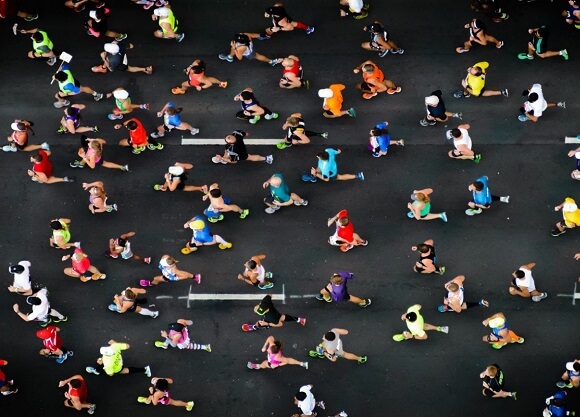
Marathons can stress the kidneys, research shows
October 18, 2017

October 18, 2017

During warmer weather, the impact of running a marathon could be even more profound, especially on the kidneys, according to a recent study published in the American Journal of Kidney Disease.
Researchers from Quinnipiac and Yale studied 22 volunteers for acute kidney injury, both men and women who ranged in age from 22 to 63. The volunteers were runners who finished the 2015 Hartford Marathon. The researchers found a possible link between the stress, the elevated body temperature and the decreased blood flow to the kidneys during exertion and a short-term reduction in kidney function.
Quinnipiac’s research was performed by Thomas Martin, associate professor of biomedical sciences and a 2017 Faculty Scholar; Rachel Pata, clinical assistant professor of physical therapy; and Karen Myrick, associate professor of nursing. They were assisted by students from the School of Health Sciences, the School of Nursing, and the Frank H. Netter School of Medicine.
Read more stories originally published in Quinnipiac Magazine
“There is a physiological reason why you feel so horrible after running a marathon. It’s because your skeletal muscles, your heart, your kidneys, undergo a considerable amount of stress and injury,” Martin said. “From a research standpoint, I’m really interested in how we can better educate runners—not only to improve performance, but also to decrease the injury risk and stress associated with marathon running.”
With more than 500,000 Americans expected to run a marathon this year, this research is both timely and provocative. Although kidney function usually returns to normal within 48 hours of completing a marathon, Martin and the other researchers wanted to know more.
They wondered about the cumulative impact of acute kidney injury on athletes who run dozens of marathons over their lifetimes. They wanted to learn more about the effect of AKI on runners based on age, gender and training regimen after high-intensity marathon running for four hours.
“What we saw in the marathon runners is what we see in a hospital with patients whose kidneys have been compromised by medical and surgical complications,” said Dr. Chirag Parikh of Yale, a professor of medicine. “It was surprising and alarming at the same time, although the recovery was brisk and prompt.”
The researchers studied blood and urine samples taken before the marathon, within 30 minutes after finishing the event and the day after finishing. They discovered 82 percent of the study’s participants presented for Stage 1 acute kidney injury, a mild decline in the kidneys’ ability to filter the body’s waste
Parikh and the other researchers studied several kidney markers for their work, including serum creatinine levels, kidney cells on microscopy and emerging proteins.
“Our study, although it was limited in sample, did open the door for a lot of new hypotheses,” said Sherry G. Mansour, doctor of osteopathic medicine and a clinical fellow at Yale. “Whether it’s because of the heat or not keeping up with hydration, we want to dive more into the mechanisms of why some people are affected and others are not. We want to learn more about the transient damage that occurs in the kidney.”
Researchers saw similarities between acute kidney injury in marathon runners and those who do strenuous work in unforgiving temperatures. While the marathon research is promising, Martin said, it’s clear a longitudinal study and a larger sample size is needed for more comprehensive data.
“Over the past few years, I’ve been very fortunate to conduct a number of studies at the Hartford Marathon,” said Martin, who has run three marathons himself. “Studies like this are challenging because of recruitment and because we’re collecting data at multiple sites on multiple days in Hartford and here at Quinnipiac. There are a lot of logistics that go into these studies, but they’re so rewarding afterward because of the impact they have on our students and the subjects.”
Others from the Quinnipiac community who worked on the studies include Johanna D’Addario, clinical assistant professor of physician assistant studies; Richard Feinn, associate professor of medical sciences; and students David Jou, Rebecca Kingston, Amanda Lafalce, Kelly Malloy, John Martin-Beaulleu Gabriella Narowska and Lauren Yuknis.
Quinnipiac Today is your source for what's happening throughout #BobcatNation. Sign up for our weekly email newsletter to be among the first to know about news, events and members of our Bobcat family who are making a positive difference in our world.
Sign Up Now